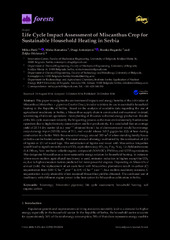Приказ основних података о документу
Life Cycle Impact Assessment of Miscanthus Crop for Sustainable Household Heating in Serbia
| dc.creator | Perić, Milica | |
| dc.creator | Komatina, Mirko | |
| dc.creator | Antonijević, Dragi | |
| dc.creator | Bugarski, Branko | |
| dc.creator | Dželetović, Željko | |
| dc.date.accessioned | 2021-03-10T13:45:41Z | |
| dc.date.available | 2021-03-10T13:45:41Z | |
| dc.date.issued | 2018 | |
| dc.identifier.issn | 1999-4907 | |
| dc.identifier.uri | http://TechnoRep.tmf.bg.ac.rs/handle/123456789/3921 | |
| dc.description.abstract | This paper investigates the environmental impacts and energy benefits of the cultivation of Miscanthus (Miscanthus x giganteus Greef et Deu.), in order to initiate its use in sustainable household heating in the Republic of Serbia. Based on the analysis of available data regarding the use of agricultural machinery in Serbia, a Miscanthus supply chain is constructed and examined in detail, scrutinizing all relevant operationsfrom planting of rhizomes to thermal energy production. Results of the life cycle assessment identify the briquetting process as the most environmentally burdensome operation due to high electricity consumption and low productivity. It is concluded that an average yield of 23.5 t dry matter (d.m.) year(-1) obtained from 1 ha of chernozem soil would have energy output:energy input (EO:EI) ratio of 51:1, and would release 365.5 gigajoules (GJ) of heat during combustion in a boiler. With this amount of energy, around 383 m(2) of a free-standing family house in Serbia can be heated annually. The same amount of energy is obtained by the combustion of 22 t of lignite or 23 t of wood logs. The substitution of lignite and wood with Miscanthus briquettes would lead to significant reduction of CO2 equivalents (eq), SO2 eq, P eq, N eq, 1,4 dichlorobenzene (1,4-DB) eq, Non-methane volatile organic compound (NMVOC), PM10 eq and U235 eq emissions. This designates Miscanthus as a more sustainable energy solution for household heating. In instances where more modern agricultural machinery is used, emission reduction is higher, except for CO2 eq due to higher emission factors predicted for more powerful engines. Depending on Miscanthus' annual yield, the replacement of set-aside land with Miscanthus plantations result in carbon | en |
| dc.publisher | MDPI, Basel | |
| dc.relation | info:eu-repo/grantAgreement/MESTD/Integrated and Interdisciplinary Research (IIR or III)/42011/RS// | |
| dc.relation | info:eu-repo/grantAgreement/MESTD/Technological Development (TD or TR)/33042/RS// | |
| dc.relation | info:eu-repo/grantAgreement/MESTD/Technological Development (TD or TR)/31057/RS// | |
| dc.relation | info:eu-repo/grantAgreement/MESTD/Basic Research (BR or ON)/176006/RS// | |
| dc.rights | openAccess | |
| dc.rights.uri | https://creativecommons.org/licenses/by/4.0/ | |
| dc.source | Forests | |
| dc.subject | bioenergy | en |
| dc.subject | Miscanthus giganteus | en |
| dc.subject | life cycle assessment | en |
| dc.subject | household heating | en |
| dc.subject | soil organic carbon | en |
| dc.title | Life Cycle Impact Assessment of Miscanthus Crop for Sustainable Household Heating in Serbia | en |
| dc.type | article | |
| dc.rights.license | BY | |
| dc.citation.issue | 10 | |
| dc.citation.other | 9(10): - | |
| dc.citation.rank | M21 | |
| dc.citation.volume | 9 | |
| dc.identifier.doi | 10.3390/f9100654 | |
| dc.identifier.fulltext | http://TechnoRep.tmf.bg.ac.rs/bitstream/id/9855/forests-09-00654.pdf | |
| dc.identifier.scopus | 2-s2.0-85055270374 | |
| dc.identifier.wos | 000448550700073 | |
| dc.type.version | publishedVersion |

